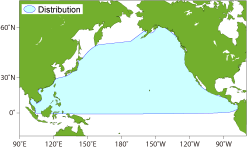- Home
- Working Groups
- Shark
- Blue Shark (Previous version)
Shark Working Group
Blue Shark (Prionace glauca) --- North Pacific
◊ Biological Profile
Blue shark is an epi- and mesopelagic shark species with a circumglobal distribution in the major oceans. It is the most widely distributed and most abundant oceanic pelagic shark. Blue shark ranges from about 50°S to 60°N.
Blue shark abundance increases with latitude in both hemispheres, reflecting preference for temperatures around 12-20°C. As a result, blue sharks are abundant near-surface in temperate waters but deeper-dwelling and less abundant in the tropics.
North Pacific blue sharks are highly migratory with complex movement patterns and spatial structure related to reproduction and the distribution of prey. Seasonal shifts to higher latitudes associated with oceanic convergence or highly productive boundary zones also occur. Their diet consists primarily of squids and small pelagic fishes.


in the North Pacific Ocean.
- Life span: About 16 years
- Maximum size: About 380 cm total length (TL)
- Start of maturity: Age 4-7 years
- Reproductive cycle: 1-2 years
- Reproductive mode: Placental viviparity; gestation period 9-12 months
- Parturition season:Variable, spring to fall
- Litter size: averages about 25-30 pups
- Size at birth: 35-50 cm TL
◊ Fisheries for Blue Shark in the North Pacific Ocean
Blue sharks are caught in large numbers in the North Pacific Ocean by longline, gillnet, recreational, and artisanal fisheries. Although considered bycatch and discarded at sea by many pelagic fleets, they are retained for human consumption, fish oil, leather and animal feed in several countries.
◊ Stock Status and Conservation Information
![]() Click here to see the latest information.
Click here to see the latest information.